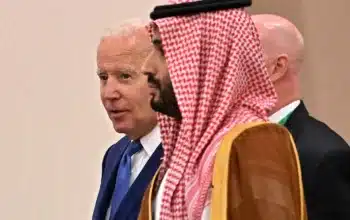Russia’s invasion of Ukraine has pushed the two countries to abandon their military neutrality for NATO.
Finland and Sweden are seeking membership to the North Atlantic Treaty Organization, a historic shift for two traditionally non-aligned countries and a major expansion of the Western alliance as war continues in Europe.
Both countries more clearly staked their new positions in recent days. After endorsing NATO membership last week, Finland’s President Sauli Niinistö and Prime Minister Sanna Marin said Sunday that the country would formally seek to join the alliance. “A new era begins,” Niinistö said. The Finnish parliament is expected to back the proposal soon.
Sweden also signaled its own plans for a NATO bid, after Sweden’s ruling party, the Social Democrats, reversed their long-held stance opposing NATO membership. On Monday, Swedish Prime Minister Magdalena Andersson committed Sweden to seeking membership. “The best for our country’s security is that Sweden applies for membership in NATO and that we do it now together with Finland,” she said.
This is a dramatic turn for two countries that have defined their geopolitical identities around nonalignment — Finland, for decades, and Sweden for two centuries. After resisting NATO membership for so long, Russia’s invasion forced Finland and Sweden to reconsider their security interests, and see ascension as a deterrent to future Russian aggression.
“This is pretty monumental,” said Katherine Kjellström Elgin, a fellow at the Center for Strategic and Budgetary Assessments. “It’s a fundamental change to the European alliance structure.”
Finland and Sweden already closely cooperate with NATO but had eschewed formal membership, a stance that worked both politically and strategically. But Russia’s full-scale invasion of Ukraine changed everything.
“Popular opinion, and the way Finnish political decision-makers see this, turned around very rapidly after Russia attacked Ukraine in February,” said Janne Kuusela, director of defense policy at the Finland Ministry of Defense. “It changed dramatically the security situation in Europe, and the way most Finns see how we best take care of our own defense and security, and how we contribute to the overall stability in northeastern Europe.”
That swing in public opinion — there is now majority support for joining NATO in both Finland and Sweden — reflected a broader awakening that the status quo with Russia would not hold. Finland felt the shock most abruptly because of its geography (it shares an 800-mile border with Russia) and its history. Joonas Könttä, a member of parliament from Finland’s Center Party who serves on the defense committee, said the common memory of the Soviet Union’s attack on Finland in 1939 led to a logical answer: “Finns realized that it could happen to us.”
Finland’s resolve is, in some ways, pulling Sweden along with it, which was a bit more politically divided on the issue, and reckoned more deeply with its longstanding tradition of nonalignment. “We will never have this sense of urgency, in the same way as Finland because of its history, its proximity to Russia,” said Anna Wieslander, the Stockholm-based director for Northern Europe at the Atlantic Council.
But Sweden and Finland’s close partnership means they will likely move in lockstep. NATO and its members are expected to openly welcome them (with a potential hiccup or two). There is also a sense of urgency. Finland and Sweden are not formally protected by NATO’s mutual defense guarantees until they are actually in the pact.
Russia, of course, is not thrilled. Moscow has repeatedly warned against NATO membership once it became clear these two were on the path toward it. On Thursday, Russia’s foreign ministry said that Helsinki must be aware of the “consequences” of its move, and Kremlin spokesperson Dmitry Peskov threatened a “corresponding symmetrical response.” Russia’s struggles in Ukraine, among other factors, make any sort of military threat against Finland or Sweden unlikely, though experts and officials believe other types of hybrid warfare are possible, like disinformation campaigns or cyberattacks.
But Finland and Sweden’s prospective NATO membership is ultimately a defeat for Putin. The war in Ukraine is about more than NATO expansion, but if Putin sought to curtail the alliance’s influence in Europe, he has only managed to broaden and deepen it. Or as Finnish President Niinistö said Wednesday, when asked how Putin would respond to his country’s NATO decision: “You caused this — look at the mirror.”
When two nonaligned countries stop being polite and start getting real(ly into NATO)
Sweden and Finland joined the European Union in the post-Cold War 1990s, but continued to embrace a policy of military nonalignment. That is, no official NATO membership.
Sweden has practiced a version of nonalignment since the 19th century. Finland’s story is a bit more complicated. The then-Soviet Union invaded Finland in 1939, and while the Finns fended off a full-on takeover in the Winter War, the threat from their neighbor persisted. That forced Finland to adopt a stance of nonalignment during the Cold War, although with quite a lot of Soviet meddling and domestic political influence.
Finland has since maintained nonalignment out of pragmatism. It shares an 800-mile border with Russia, and the two governments maintained neighborly relationships, even as it invested very seriously in its defense, including maintaining a conscription army.
Especially in recent years, Finland and Sweden have become strong partners with NATO — they are basically as close as a country can get to the alliance without formally being in it. They do military exercises together and share some intelligence; both Sweden and Finland supported NATO’s mission in Afghanistan. And NATO’s open door remained, well, open to Sweden and Finland, but was not something either had to pursue unless the security situation in Europe drastically shifted. Which is exactly what happened when Russia began threatening Ukraine.
/cdn.vox-cdn.com/uploads/chorus_asset/file/23463234/GettyImages_1240594905.jpg)
Frank Augstein/WPA/Getty Images
Last December, as Russia built up troops along Ukraine’s border, Moscow issued ultimatums that sought to remake the European security architecture — demands like no NATO enlargement, and a Russian sphere of influence. That rattled Sweden, but it really shook Finland. Wieslander, of the Atlantic Council, said, for Finland’s leaders, it was a reminder of the very limited space Finland had to operate during the Cold War, both internationally and domestically. Moscow’s demands created this “feeling that Finland’s road to be part of the West could not be jeopardized, and that the informal position that Finland could have in relation to NATO was not strong enough.”
That kicked off the soul-searching in Helsinki; Russia’s Ukraine invasion delivered the shock. In Finland, support for NATO typically hovered in the 20 or so percent range. In January 2022, less than 30 percent of the Finnish public was in favor of NATO membership. After Russia’s invasion, it rose 53 percent, to an incredible 76 percent in May.
As extraordinary as the swings in public opinion were, Finland’s already close ties with the West and with NATO helped make the possibility of membership more palatable. “It’s still much more an evolution rather than revolution, in a way, the attitude towards NATO,” said Sinikukka Saari, a leading researcher on Russia at the Finnish Institute of International Affairs.
Finland and Sweden, as EU members, joined the strong sanctions against Russia, and both sent military equipment to Ukraine. They were united with the West, except actually being part of NATO, and after Russia’s invasion, it exposed a vulnerability, especially for Finland.
In Sweden, experts said, the calculus is a bit more complicated. Support for joining NATO has jumped by double digits since January to about 57 percent, according to April polls. But the backing does not yet appear to be as dramatic as in Finland. Sweden holds tightly to a perception of itself as a neutral country, an identity it has preserved throughout major conflicts in Europe, including two World Wars and the Cold War. “The decision not to join NATO for Sweden, more so than Finland, was rooted in the neutral, nonaligned identity,” Elgin said.
The Social Democrats, who run Sweden’s minority government, have traditionally been opposed to NATO membership; it’s a position they reiterated in November. In March, Prime Minister Andersson rejected the opposition’s calls to join NATO, saying it would destabilize Europe even more. She only proposed reviewing the security situation last month, leading up to Sunday’s about-face. The Green and Left parties are still opposed. Sweden’s right-leaning opposition parties have tended to be more supportive of NATO membership, and are backing a current bid. Adding to the tension are national elections in September. “The question about NATO membership has been deeply polarized between the parties,” Wieslander said, adding that has slowed the debate, even if Sweden ultimately ended up in the same place as Finland.
Finland and Sweden’s strong bilateral partnership almost guarantees neither would make a move if they thought the other would balk. “I would stress that we are doing this together,“ said Erkki Tuomioja, a Social Democrat in the Finnish Parliament, who previously served as a foreign affairs minister.
Finland’s push for NATO membership was also a process. Könttä, who is on the defense committee, said when he ran for Parliament he stated Finland had no need to join the alliance. In December, he began privately reassessing his views. In March, he announced his change of position.
Tuomioja, meanwhile, said that he would support Finland’s NATO path, but he still is somewhat skeptical. He said he would have liked to consider other options, but in the public, and in parliament, NATO is seen as the strongest security guarantee.
“Whether or not you think this is the best idea to join NATO,” he said, “it’s always better that Sweden and Finland do things together.”
What does this mean for NATO? And everyone else?
There’s another benefit of Finland and Sweden going in together: It reduces some of the risk of announcing you’re going to be in NATO.
The risks lie largely in how Russia reacts. Moscow has already threatened Sweden and Finland over NATO membership. On Saturday, the Kremlin’s press service said Putin had told the Finnish President Niinistö that abandoning its nonalignment would be an “an error since there are no threats to Finland’s security.” On Monday, Putin seemed to accept the inevitable by saying Russia has no problems with Finland and Sweden, and so “in this sense there is no immediate threat to Russia from an expansion to include these countries.” Still, Putin warned that the expansion of military infrastructure there “would certainly provoke our response,” according to Reuters.
Putin has blamed the West for the war in Ukraine, and NATO’s likely expansion — along those 800 miles at Russia’s border — certainly plays into that narrative. “If Finland and Sweden actually also joined NATO, then that will just be a detail that somehow proves that the Russians were right,” said Martin Hurt, a research fellow at the International Centre for Defense and Security and a former Estonian defense official. “But the rest will still be made up of lies and disinformation.”
Even so, Finland’s or Sweden’s NATO membership likely would not resonate for Putin the same way as, say, an ascension of a former Soviet republic. Finland may sting a bit more, but as an EU member and NATO partner, Moscow likely already sees them as tied to the West. . “Russia will see Finland’s NATO membership as some sort of defeat and betrayal, but it is or should be much easier to accept than what was for example the membership of the Baltic states in the alliance,” Tuomas Forsberg, an international relations expert and the director of the Helsinki Collegium for Advanced Studies, wrote in an email.
It seems like if you’re going to join a military alliance the Kremlin sees as an existential threat, you should do it while Russia’s military is bogged down in a protracted war in Ukraine. Still, there is no doubt that Finland and Sweden are at their most vulnerable right after they announce their NATO intention but lack its formal protections. “There is a general feeling that this kind of gray period should be kept as short as possible,” Saari said.
NATO will likely make an effort to keep that window as short as possible, though the timeline is still a little bit fuzzy. Of recent ascensions, it took Montenegro 18 months, but there’s a general expectation that Finland and Sweden will proceed even more rapidly. Andersson said Monday that Sweden expects “it shouldn’t take more than a year.”
Both meet the political criteria, as strong, established democracies, and the close cooperation with NATO means they already have a high level of interoperability — military speak for their systems and tactics being in sync. “In that sense, there’s very little of a delta that they have to step up to achieve,” said Steven Horrell, a nonresident senior fellow at the Center for European Policy Analysis. Finland already spends close to the 2 percent on its military that NATO targets for its members, and Sweden already planned to increase its military spending over the next decade.
NATO members, even before Russia’s war, made it pretty clear that if Finland and Sweden wanted in, NATO would eagerly have them. NATO Secretary General Jens Stoltenberg said in a statement Thursday that should Finland apply, “they will be warmly welcomed.”
Still, each NATO member does have to approve the bids, and some countries, like Turkey, are trying to use this moment to advance their own demands. But this is likely more grandstanding than actual opposition, and officials are likely to quietly hammer out any disagreements. US and NATO officials have indicated that all members are ultimately expected to back their ascension.
In the meantime, NATO and its members are offering some assurances during the application period. A White House spokesperson told Vox the US is “confident that we could find ways to address any concerns either country may have about the period of time between a NATO membership application and their formal accession to the Alliance.” The United Kingdom offered more formalized security guarantees this week.
Finland and Sweden’s ascension to NATO will also likely reshape the alliance, even in subtle ways. Inclusion of Finland and Sweden will transform how it does its military planning in the Nordic, Arctic, and Baltic regions. NATO will expand its boundary with Russia, accessing a new front from which to pressure Russia, but also one it is now obligated to protect.
NATO still faces some very real strategic challenges, with or without new members. But Finnish and Swedish membership is politically symbolic for the alliance. “Putin talked before this third invasion of Ukraine about redrawing the global security architecture,” Horrell said. “And, well, that’s one thing he’s achieved, but I think not quite the way he wanted to.”
Author: Jen Kirby
Read More



